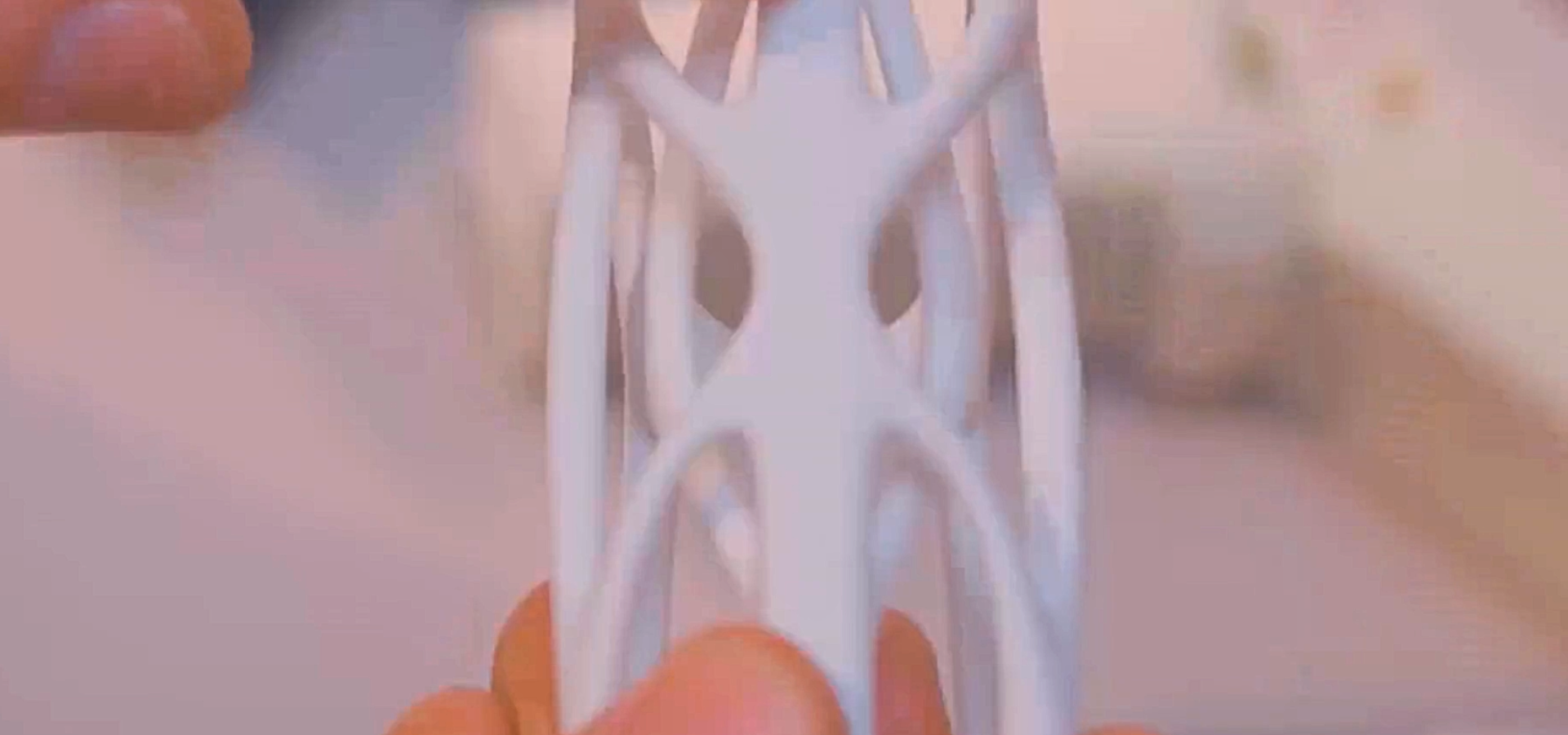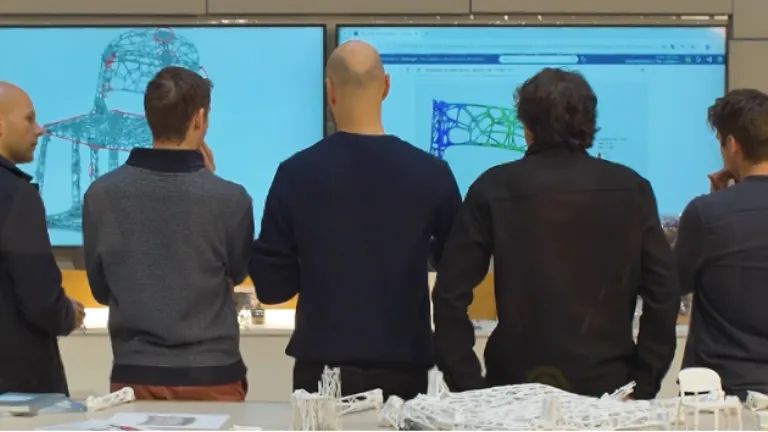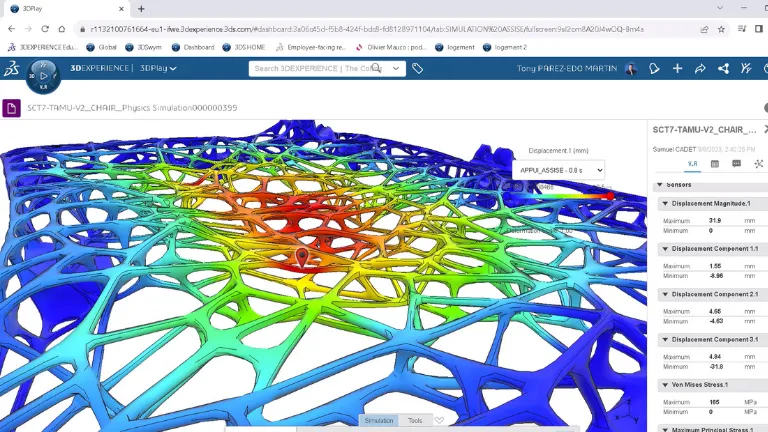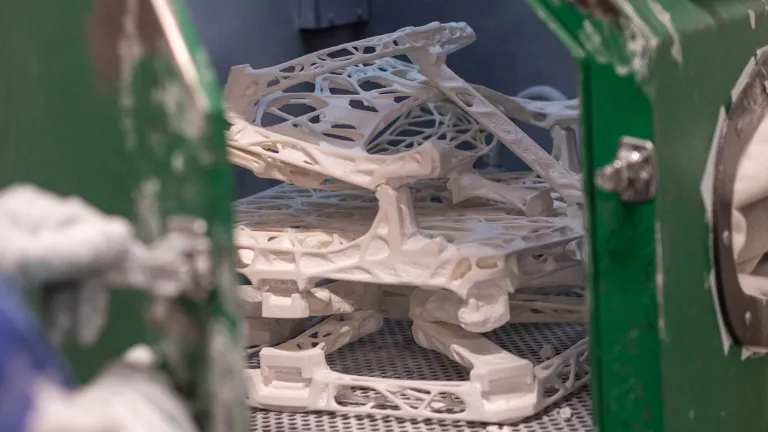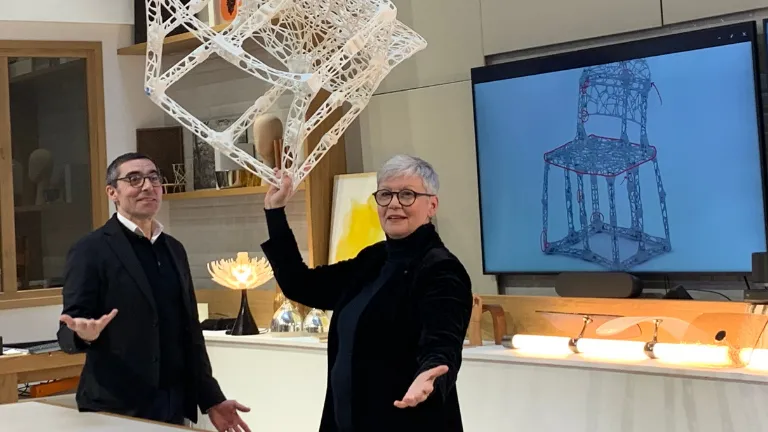TA.TAMU
Leading the way in design for the regenerative economy.
A collaboration between designer Patrick Jouin & Dassault Systèmes’ Design Studio.
A Frugal Design Feat for the Regenerative Economy
The vision behind Ta.tamu was to design a lightweight, foldable chair with a unique aesthetic, with a view to 3D print it locally. It explores the intersection of art and science, human and machine, designer and data, as well as modeling and simulation.
The focus is on minimizing material usage through topology optimization and printing the chair in its folded form. By integrating design, simulation, and life cycle assessment early in the creative process, Ta.tamu aims to transform traditional business models—promoting local production instead of shipping—and empowering self-edition and customization.
TA.TAMU in 3D
Click below to launch the 3D experience and discover its secrets!
(on mobile devices, you’ll see it in Augmented Reality)
Prepare for the Regenerative Economy
Discover a breakthrough design process
- Re/generative Design
- Generative Design & Topology Optimization
- Modeling & Simulation
- 3D Printing & Sustainability
Leveraging design systematically
For us collectively to improve the world we live in, we have to change the way we produce, design and use materials. Ta.tamu represents a call to action for industry to embrace the generative economy instead of continuing to create without limits.
To make the vision come true, we put together a multidisciplinary team, gathered around a collaborative space for imagining, learning, exploring, innovating... in V+R.
On the 3DEXPERIENCE platform, teams generate and capitalize knowledge & know-how, with continuous testing loops, creative and scientific interactions, facilitating decision-making from ideation to production.
GENERATIVE DESIGN
Patrick Jouin - TAMU
Passionate and ambitious, French designer Patrick Jouin constantly investigates emerging technologies, as demonstrated by his 2004 series Solid (C1 & C2), the first collection of furniture printed in 3D.
A high-tech dialogue between form and function
Generative design enables the simultaneous optimization of aesthetic and structural performance by leveraging algorithm-driven exploration of design spaces.
The workflow evolved from SOLIDWORKS to the more advanced CATIA 3DEXPERIENCE platform, benefiting from a standards-based interoperability approach that allows seamless data exchange and shared functionality between the two systems with minimal end-user intervention.
By applying biomimicry-inspired algorithms alongside topology optimization, the team generated highly complex, organic geometries that exceed conventional design constraints.
The aim was to generate a lightweight, folding chair that minimizes material usage while maintaining structural integrity and performance.
MODSIM at concept stage
MODSIM unifies modeling and simulation on a common data model within a single user experience.
Its development was driven by the power of CATIA and the MODSIM approach with SIMULIA. Following topology optimization, the team iterated continuously within a unified data model and user experience, integrating modeling and simulation to refine details, improve stress points, reduce weight, enhance strength, and minimize material usage.
The result: a chair weighing just over 3 kg, folding in 30 places, demonstrating how digital engineering and interdisciplinary collaboration can deliver sustainable, high-performance solutions inspired by nature’s principles.
This approach bridges the gap between designers and simulation analysts, enabling faster and earlier identification of optimal design alternatives.
By embedding simulation directly into the design workflow, engineers can accurately predict product behavior, accelerating innovation while reducing risks of late-stage failures, rework, and uncertainty.
Aiming for the regenerative economy
The philosophy of using the least material possible is embodied in the design itself—visible and tangible.
Pursuing lightness is only part of the challenge. This chair represents an ongoing evolution—refining concept, process, and material in unison. We’re not finished; design is an iterative journey.
Material efficiency is central: flat 3D printing significantly reduces print time and material consumption. Life Cycle Assessment confirms reductions in both material use and carbon footprint through optimized additive manufacturing techniques.
The shift to local production is key—transforming the physical chair into a ready-to-print digital asset, enabling decentralized, on-demand fabrication.
From TAMU to TA.TAMU, Exploring Form & Function
Dassault Systèmes’ Design Studio and Patrick Jouin iD have been collaborating since 2018. Together, we launched Tamu, a prototype chair, at Milan Design Week 2019.
Advocating a participatory approach to new technologies and virtual worlds, Dassault Systèmes’ Design Studio leads experimental projects at the intersection of art and science, demonstrating the value of design for the well-being of citizens and society.
From idea to design, Tamu was a bold experiment, a play with patterns and aesthetics revealed thanks to 3D printing. Ta.Tamu is the 2nd chapter of the story. While Tamu was an exploration of forms and patterns, TaTamu explores form and function.
Ta.tamu also manifests ways for industrial players to prepare and adapt for the regenerative economy.
Join our COLLIDERS Community
COLLIDERS is a community of design thinkers and makers keen to engage in collaborative and sustainable innovation — colliding, designing, making, creating, sharing and coaching each other.
COLLIDERS provides a dedicated environment on Dassault Systèmes’ 3DEXPERIENCE platform with Cloud access to Design Studio expertise, Dassault Systèmes roles, rich 3D content and powerful applications.
Discover More
Dassault Systèmes & the 3DEXPERIENCE platform
Dassault Systèmes’ 3DEXPERIENCE® platform is the catalyst for uniting artists, scientists and makers in a dynamic process of renewable innovation. By collecting and displaying knowledge from dozens of disciplines via virtual twin experiences – scientifically accurate simulations of objects and the world in which they will exist – the platform provides a space for collaboration. For the first time, virtual twin experiences enable us to conceptualise and fully understand our creations’ renewal potential.
